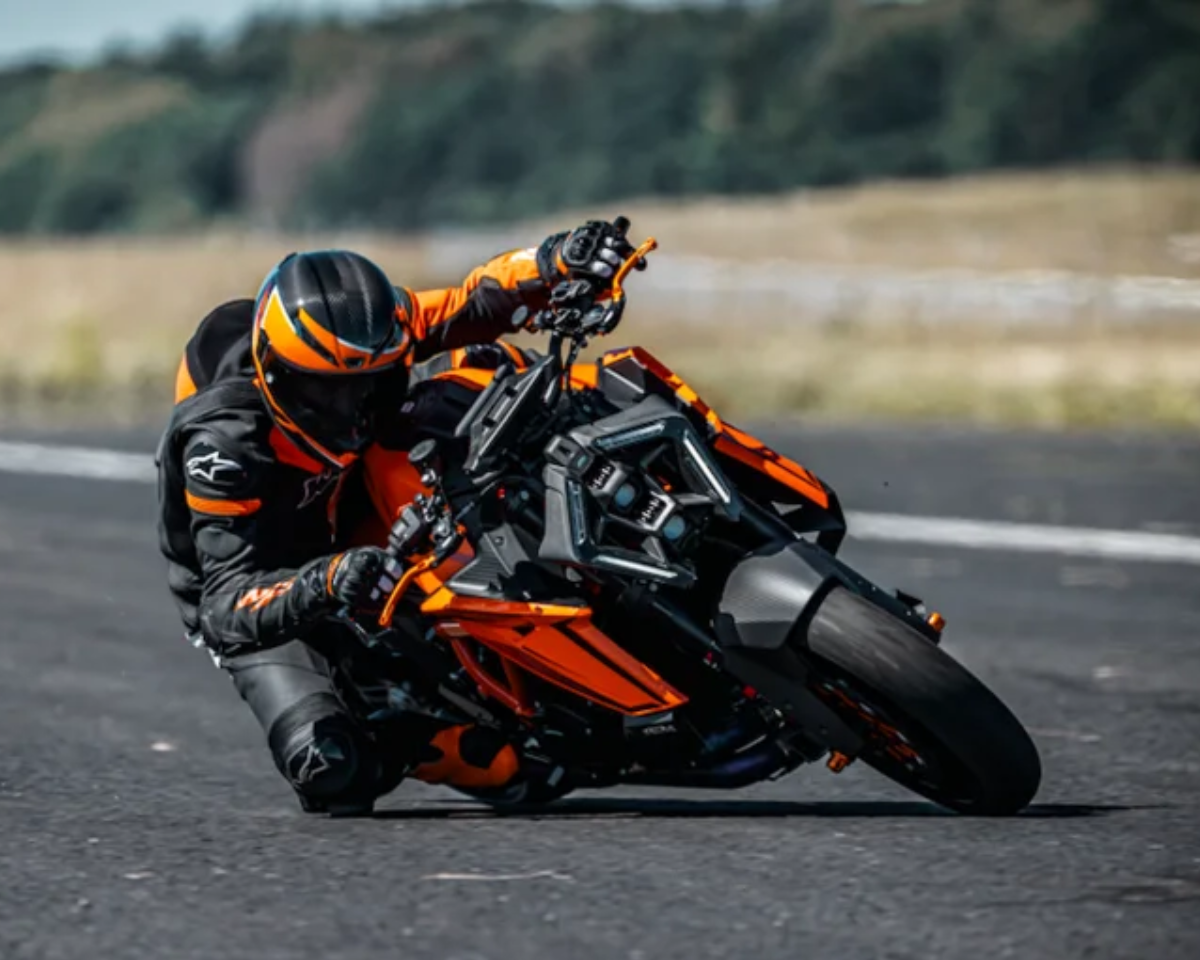Typically, we don’t cover any European lifestyle motorcycle brands filing for bankruptcy. Most brands have been in trouble more than once in their history. The lifestyle motorcycle industry is passionate, and the market is brutal.
But when KTM’s parent, Pierer Mobility AG, announced plans for voluntary judicial restructuring a few days back, we had to sit up, take notice, and analyze. It’s not just brands under the group umbrella – KTM, Husqvarna, Gas Gas, and Moto Guzzi, that get impacted if Pierer gets disrupted. There is also an extended universe stretching from Bajaj Auto in India to CF Moto and Zeeho in China, suspension manufacturer White Power (WP), and KISKA design in the immediate neighborhood, all strongly linked to Pierer. The lines would be redrawn.
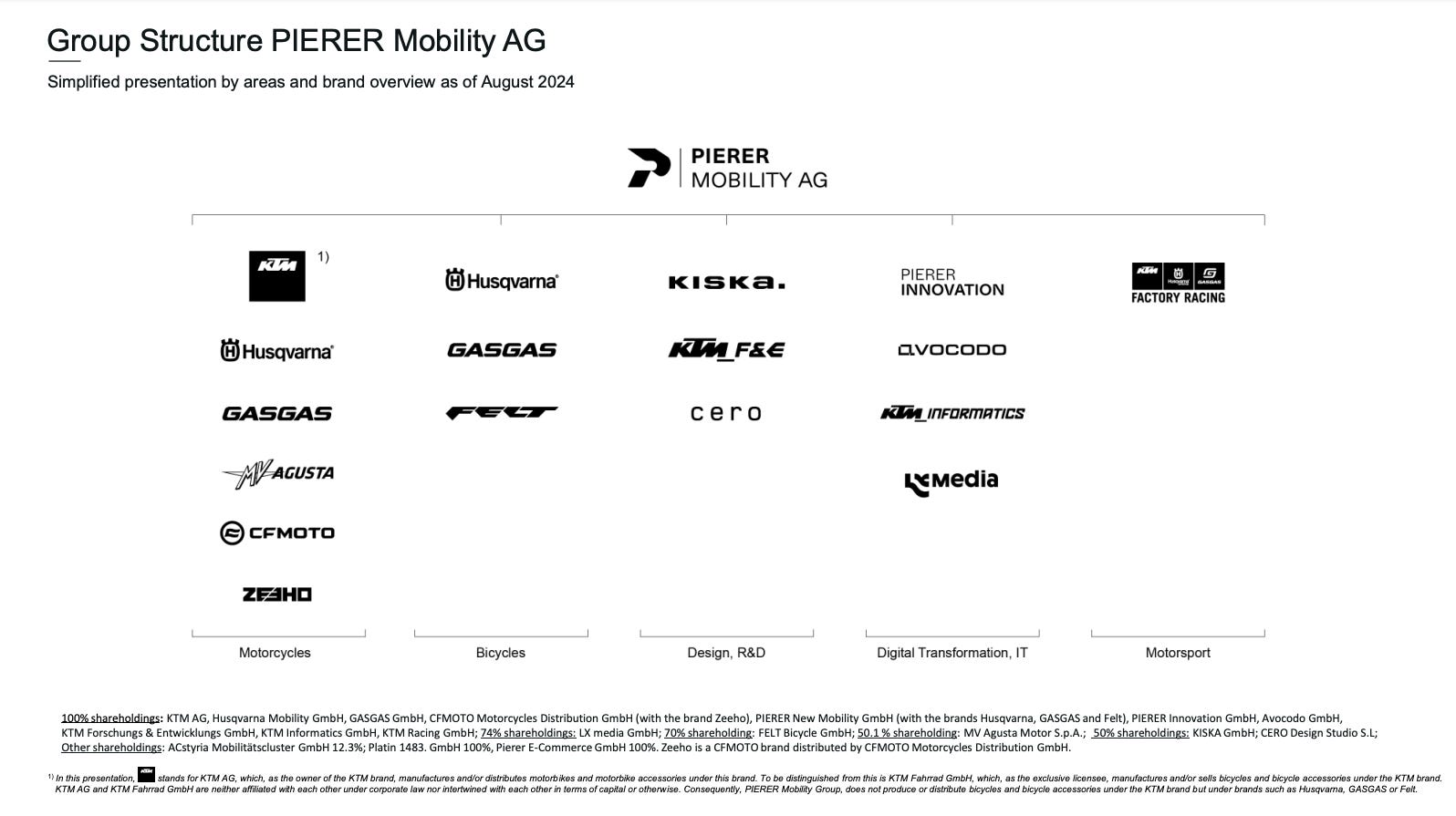
Pierer Mobility’s Voluntary Filing for Judicial Restructuring
The voluntary filing is Pierer’s defense against any forced liquidation. As per the news release of 26th Nov from the company:

The news release further mentions that Pierer Mobility AG has 90 days to agree with the creditors about reorganizing the group. That puts the D-day at 24th February.
The writing has been on the wall for the last few weeks since Pierer announced its half-yearly results. To say they were bad is an understatement—sales fell off a cliff, and Pierer said KTM would cancel the 2024 guidance. They said that the market conditions in North America and Europe remained weak. KTM also reduced the Executive Board from six to two members: Stefan Pierer (CEO) and Gottfried Neumeister (Co-CEO).
They do need a Co-CEO right now as work has just gone through the roof.
Then, on 12th November, they issued another release where Pierer Mobility said:
In the course of liquidity planning for the 2025 financial year, PIERER Mobility AG has to cover additional liquidity requirements at the level of KTM AG. As of June 30, 2024, the KTM AG Group was responsible for more than 95% of PIERER Mobility AG’s revenue.
The Executive Board is currently working on securing the financing of KTM AG, in particular on a bridge financing in the three-digit million range. To this end, discussions are ongoing both with the core shareholder Pierer Bajaj AG and with existing financial creditors. The aim is to agree a standstill agreement with the financial creditors involved for the duration of these discussions as basis for the financial restructuring.
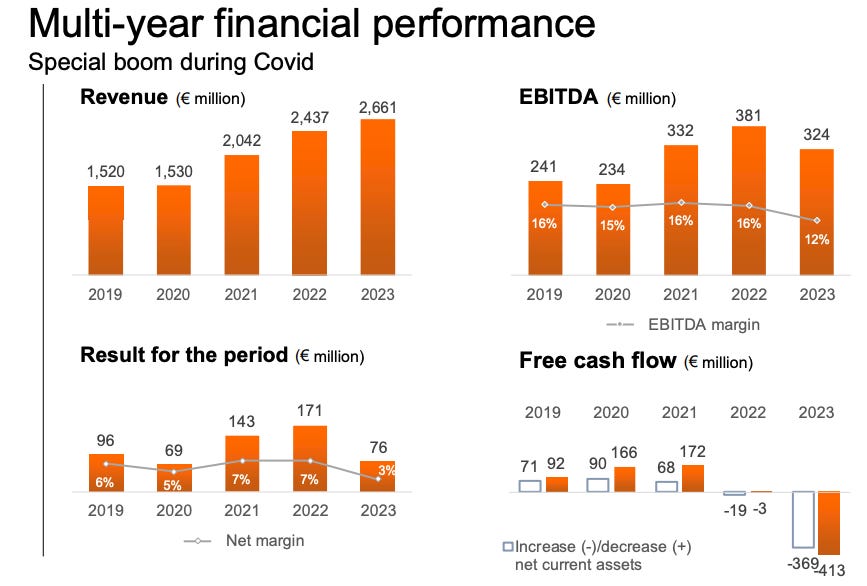
How did KTM end up here?
2022 was Pierer Mobility’s best year ever. Revenues crossed EUR 2.4bn, it hit an all-time EBITDA high of EUR 381m, and it reported EUR 171m in net profits, operating at a healthy 7 percent net margin.
However, the warning signs were there. 2022 was the year Pierer Mobility’s Free cash flow dipped marginally into negative. This was due to spiking working capital requirements. Not many noticed as this was a marginal blip.
Then, in 2023, things started going wrong; we can see that now because we analyze this at the end of 2024 with the benefit of hindsight. Revenues were still growing in 2023—the best revenue year ever at EUR 2.66bn. EBITDA dipped by 15 percent to EUR 324m. However, the biggest red flag was the dip in net profits. At EUR 76m, they had collapsed by 55 percent.
There were liabilities to be met due to higher interest on higher debt due to higher working capital requirements.
But why did the working capital requirements shoot up, starting in 2023 and continuing in 2024?
Sales Declined Drastically.
KTM reported wholesales of 381,555 units in 2023. This was an improvement of 6063 units over 2022 sales, only a 1.6 percent improvement. But then sales dropped drastically in 2024. In H1 2024, KTM could sell only 147,496 motorcycles, 21 percent down year-on-year from 187,158 motorcycles sold in H1 2023.
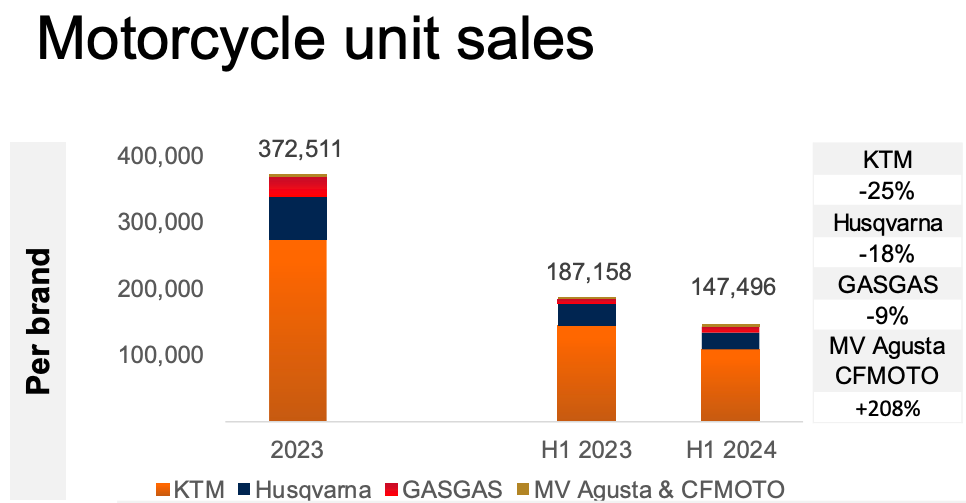
But why did sales decline? Pierer Mobility says the market is bad, which is not completely true. KTM-Husqvarna-MV Agusta-GasGas has lost significant market share while the competition is doing way better.
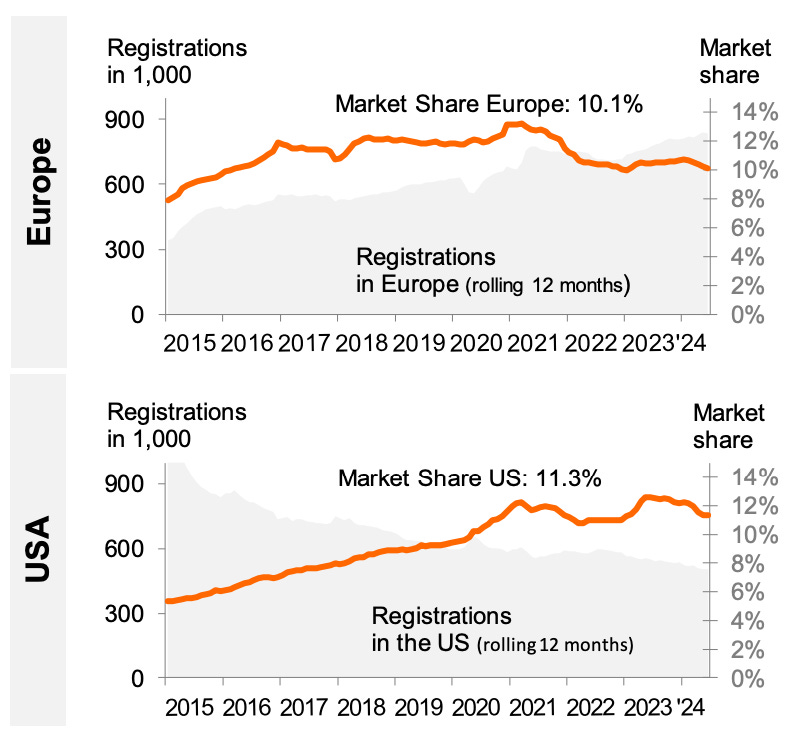
To put it in perspective, Triumph sales are booming thanks to the new 400s; Ducati is down somewhat, though nowhere comparable to KTM; and BMW Motorrad had record sales in 2023 and is holding steady at that level in 2024.
The comparison between the Triumph and KTM is more apt. If Triumph sales are booming thanks to the Bajaj-made 400 range, KTM (and Husqvarna) have always enjoyed having the widest single-cylinder (125-400cc) range in the European and North American markets, all manufactured (non-motocross) by Bajaj Auto.
When the European and North American motorcycle markets came off the highs in 2024, KTM was the worst affected. The impact of quality issues started hurting badly in recent quarters. No one wants a large lifestyle motorcycle with a problematic engine—replacement components are expensive. In the case of KTM, the camshafts on the 790/890 series LC8C engine failed, at times, within 20k km of use.
CF Moto in China assembles the engine and the 790/890 motorcycles. However, KTM remains responsible for ensuring quality.
KTM further worsened the situation by not promptly addressing the quality issues, antagonizing customers. As customers walked away, resale prices plummeted, putting KTM in a vicious cycle. People don’t buy large, lifestyle motorcycles that depreciate fast.
Meanwhile, sister brand Husqvarna remains small and has never really taken off since its resurrection a few years back.
A Domino Effect Triggered
This sales slowdown should have resulted in a corresponding cut in production. However, that did not happen for some reason. Maybe the slowdown was shockingly sudden, and the production planning did not get ample warning.
For whatever reason, inventory kept piling up at the dealer and factory ends. At the end of 2023, KTM had EUR 857m in inventory at the factory and dealers combined. That represents more than four months of sales. Large two-wheeler manufacturers try to keep inventory levels at two months. Modest-size lifestyle motorcycle manufacturers are expected to be sharper.
Suppliers also did not slow down production. In all fairness, Pierer Mobility supported the dealers and suppliers by increasing working capital, believing in its strong balance sheet. The debt piled up. We covered things in short in a daily update. The cusp of the problem is Pierer Mobility’s debt situation. From the annual financials for 2023:
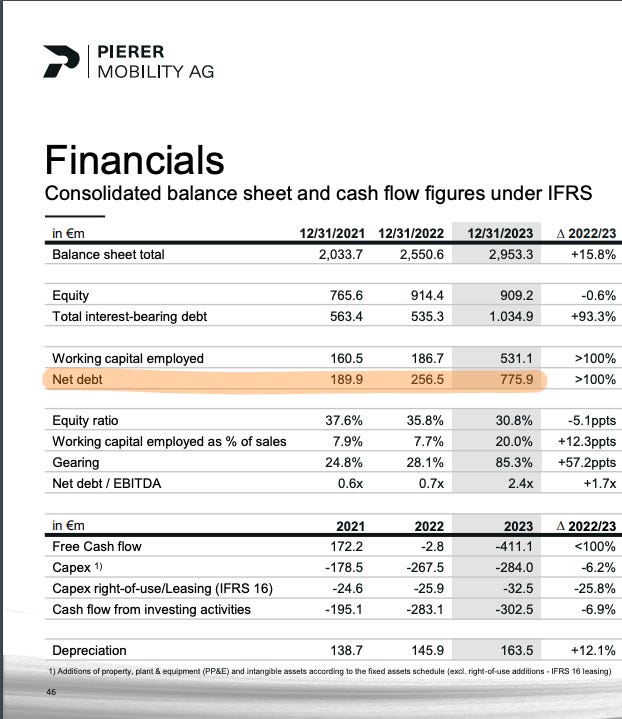
Debt climbed sharply from EUR 190m in 2021 to EUR 776m at the end of 2023, thanks to a significant increase in working capital.
The situation would further worsen in H1 2024 as Free Cash Flow continued to collapse:
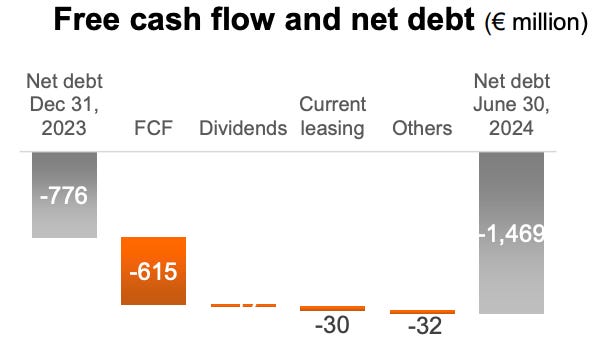
Pierer Mobility’s debt climbed to nearly EUR 1.5bn at the end of H1 2024. The company says the average cost of debt is 4.3 percent annually. Within H1 2024, the group paid EUR 22m in servicing the debt.
Some debt needs to be serviced this year.
Two things are happening: interest rates have increased, and some of this debt is coming up for repayment. However, Pierer Mobility has no reserves to repay the debt at such short notice. The board has been trying frantically over the last few weeks but has not made a breakthrough. That is why the pre-emptive judicial restructuring move was needed.
In short, the KTM crisis can be summed up as
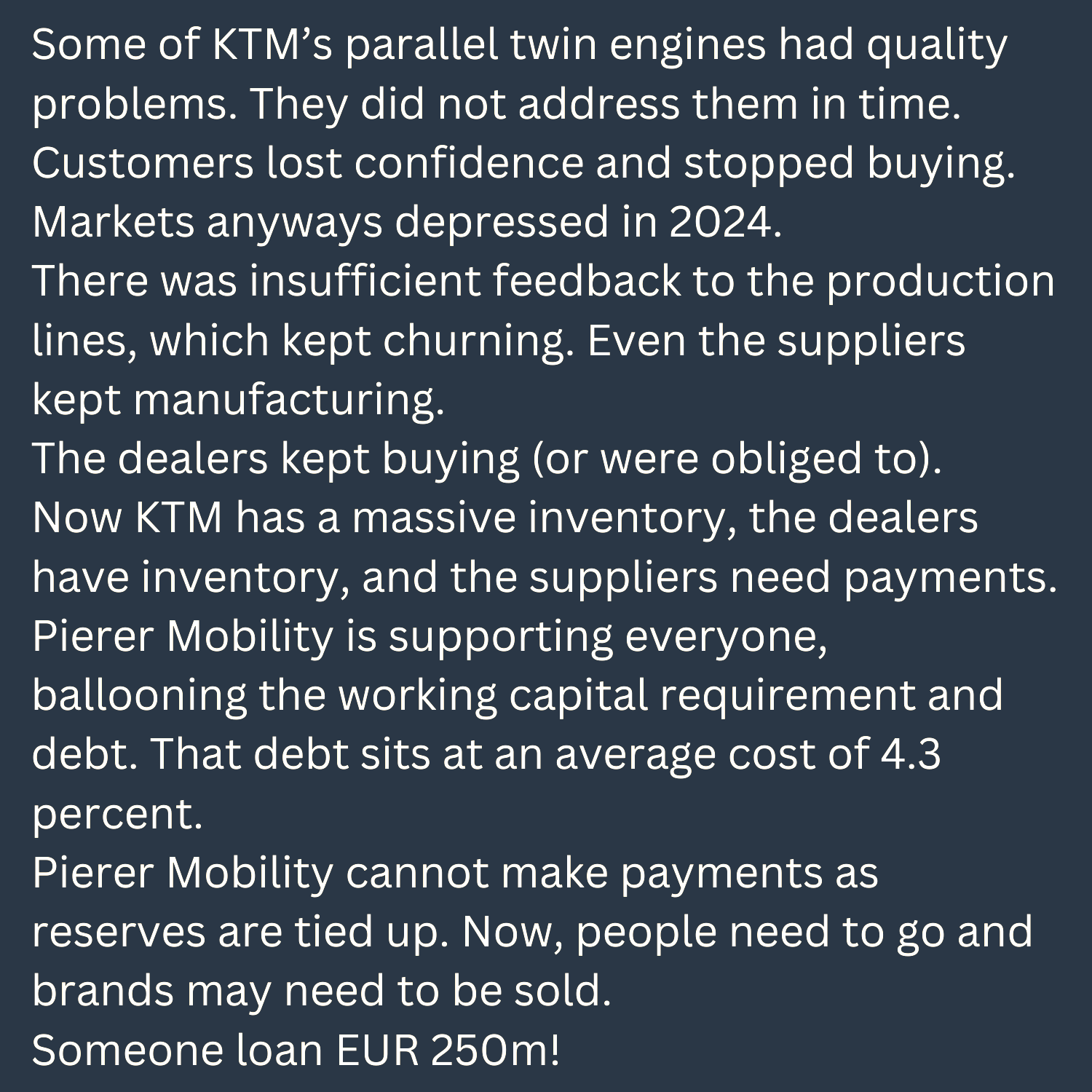
What now?
Pierer Mobility is probably talking to creditors about restructuring the loans. That may be the easy part. Before the crisis, the group was healthy, with strong financial and technical backing. Creditors would be willing to restructure the loans to ease immediate pressure.
More than half the debt is linked to the inventory at KTM and its dealers. Once that inventory is eased off, the debt will, too. That is KTM’s biggest problem. When a lifestyle brand is down and there is a bad buzz around quality issues, resale prices collapse. Any discretionary purchases need buyer confidence, and KTM does not have too much going for it.
Pierer Mobility realizes that, and they have put a two-year timeline for inventory to return to normal levels. That indicates how bad the situation is, how massive the inventories are, and how slow they expect sales to be.
Pierer plans to lay off people at Mattighofen, Austria, in the short term. As many as 300 people may be laid off, as production would be temporarily halted for at least two months.
Apart from this, Pierer Mobility recommitted to tight cost management and streamlining of the development process.
What seems like shortsighted exuberance now
Given the terrible current financial situation, some of the decisions of the last two years now appear like shortsighted exuberance that could have been avoided or thought through better. Mainly:
- The MV Agusta acquisition was one such move. Pierer Mobility now owns 50.1 percent of the sports-luxury Italian brand. There is debt on the books that Pierer had to take as part of the acquisition, though it may be small when compared to the total debt in Pierer Mobility’s balance sheet.
- The dividend payout in 2023 now seems questionable. Pierer Group paid over EUR 68m in dividends in 2023. Given the market and financial situation had already started deteriorating in 2023, dividend payout was not the best use of cash.
- MotoGP participation: With MV Agusta comes the eventual MotoGP aspirations. That’s great for good times. MotoGP is an essential part of research and engineering, and with both KTM and MV Agusta known for making sharp machines, a MotoGP team is a good fit. But MotoGP teams are costly to manage and operate, and this may be the time to put the team on pause.
- The electric programs may suffer even more. This is unfortunate but likely. We have noticed that KTM-Husqvarna’s electric programs are running late, and the brands have scaled back their ambitions to do only 48V systems. That counts less than 250cc motorcycles, though more likely 125cc equivalent ones. KTM and Husqvarna recently unveiled the E-Freeride and Pioneer at EICMA 2024. Both programs were about 18 months late. The e-Duke naked electric motorcycle has also not made an appearance till now. With cash being a problem, KTM may likely delay things even further.
What still works for KTM
Not everything is bleak for the Austrian brand. Some KTM products have reported reliability problems, but not all of them. KTM stays true to the brand’s core attributes for most of its range. It has a very large fanbase.
Importantly, the product pipeline has been working well, and KTM’s large motorcycle range is fresh. The new 390s have come, and since Bajaj makes them, the planned cuts would not impact production.
KTM is also up to date on technology. From new frames to AMT transmissions for its large motorcycles and TFT touchscreens, KTM has worked hard to stay benchmarked and ahead of the competition.
Does Pierer Mobility Need a Savior?
If the financial restructuring is successful and the creditors agree to it, there will be short—to medium-term pain, but Pierer Mobility can scrape through on its own. However, a EUR 200-300m cash infusion would help more.
Media outlets point to India-based Bajaj Auto as a likely savior. Bajaj Auto owns a 49.9 percent stake in Pierer Bajaj AG, the holding company that holds 74.9 percent of Pierer Mobility.
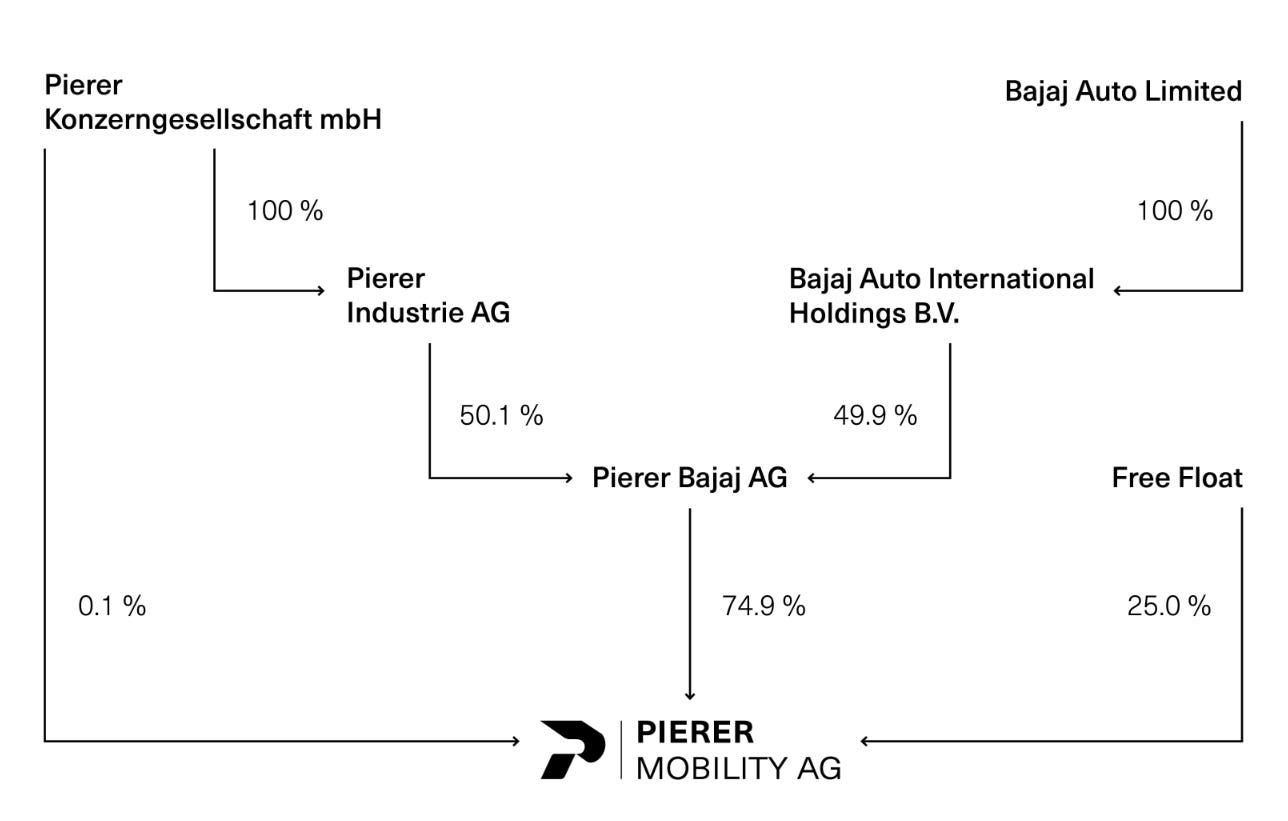
Bajaj Auto is huge. As we write this, it has net sales of USD 5.44 bn and a market cap of nearly USD 30bn. Bajaj has a deep relationship with KTM. They are responsible for partially developing all the single-cylinder (125-400cc) (non-offroad) models for KTM and manufacturing them in India. Bajaj is also responsible for KTM-Husqvarna sales in India and Indonesia.
Bajaj has huge cash reserves and can easily increase its stake in Pierer Bajaj to eventually control Pierer Mobility through a cash infusion.
But there is nothing in this for Bajaj beyond the pride of owning a few sporty European brands with whom it already has a deep relationship. For a large manufacturer operating at more than 18 percent net margins, acquiring a debt-ridden European motorcycle group that, in its best year, operated at a 7 percent net margin does not sound financially attractive.
At the same time, Bajaj is unlikely to let KTM go under. KTM generates a lot of co-development and profitable business for the Indian manufacturer, so if things hit the ceiling, Bajaj would step in.

